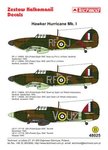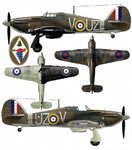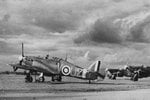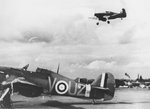Navigation
Install the app
How to install the app on iOS
Follow along with the video below to see how to install our site as a web app on your home screen.
Note: This feature may not be available in some browsers.
More options
You are using an out of date browser. It may not display this or other websites correctly.
You should upgrade or use an alternative browser.
You should upgrade or use an alternative browser.
Polish Sqdn BoB Hurricane
- Thread starter rochie
- Start date
Ad: This forum contains affiliate links to products on Amazon and eBay. More information in Terms and rules
More options
Who Replied?Karl I have gone through a few references and didn't find anything about the early camo scheme of the Hurricane. All pictures I have seen show tha Hurricane with the Sky band of fuselage. I think the plane might have been painted with the camo scheme only. If she wasn't it would be pattern without the Sky band and the black left wing.Possible the spinner could have been black painted.
Last edited:
Airframes
Benevolens Magister
The Squadron was formed on 28 August, becoming operational on 8 September, whilst still at Church Fenton (13 Group). I don't have any info about their involvement in the BoB at all, the only Polish squadrons being operational in the Battle itself being 302 and 303. The Squadron became properly operational after their move to Northolt in April 1941.
However, before November 27 the colour scheme would have been overall Sky undrsides, no fuselage band, and a black spinner.
However, before November 27 the colour scheme would have been overall Sky undrsides, no fuselage band, and a black spinner.
Terry , according to my info the squadron was ready operationally on 7th November 1940 when was moved to the Tern Hill airfield.
Attachments
Last edited:
Airframes
Benevolens Magister
You are quite correct Wojtek. The Squadron was declared operational on 8 Septemebr, and moved to Tern Hill, in November, after the official end of the Battle. The Squadron is not included in the listings of Squadrons which took part in the Battle, and remained in Yorkshire until the move to Shropshire, for the defence of the the north west and Wales, and convoy duties off the west coast.
Oh...So I have understood you wrongly.Now it sounds correct. Undoubtedly the squadron didn't participated in BoB in the way the 302 and 303 one did. I have told Karl about it.And it might be the reason for the lack of pictures with their Hurricanes of the early camo scheme in.
- Thread starter
- #8
Thanks guy's i'll go with RF-F as thats included on the decal sheet, just thought UZ-V looked more interesting but never mind i'll do another Hurricane as UZ-V later
Airframes
Benevolens Magister
I've found a profile of the unit in the earlier scheme when you need it Karl.
Bernhart, the aircraft seen landing is a Miles Mater, advanced trainer.
Bernhart, the aircraft seen landing is a Miles Mater, advanced trainer.
Great profile and pics, Wojtek.you must do this one later Karl!
vikingBerserker
Lieutenant General
Very cool!
On 21 August 1940 Col Iwaszkiewicz, Deputy Inspector General of the PAF, issued an order to F/Lt(Cpt) Tadeusz Rolski to begin organizing a fighter squadron - the third one in Britain at the RAF Polish Depot in Blackpool. The squadron became No. 306 (Polish) Fighter Squadron and under the relevant RAF order of 28 August was formed at Church Fenton, within No.l3 Group. The unit was assigned the code letters UZ. Its personnel were mainly drawn from officers and men of the former 4th (Toruń) and 3rd (Poznań) Air Regiments and
the Squadron adopted the name No. 306 Dywizjon Mysliwśki Toruński ("Toruń" Fighter Squadron). The "Wild Duck" emblem of the Toruń III/4 Fighter Dyon on the diamond background of the 3rd Regiment's insignia formed its badge (not officially authorized by the RAF) which also carried at the top the Warwick Bear and Staff of No. 605 Squadron, whose former C.O., S/Ldr Scott, became the British commander of No:306. S/Ldr (Mjr) Jerzy
Orzechowski was earmarked to take over the Polish command from Rolski at a later date.
On 2 September Rolski, who became the Acting S/Ldr,was instructed to proceed with the selected personnel to the RAF Station Church Fenton near Tadcaster (Yorks), but because of the dispersal of Polish airmen in various camps, he was able to muster only 12 pilots - out of the 25 assigned him and 109 ground personnel. They rnoved to Church Fenton on 4th September. Six more Polish pilots arrived on the 19th and the remaining seven and the rest of the ground crew on the 24th. The pilots commenced flights on the dual-control Fairey Battle and Miles Master I (serial N8007) trainers on 10 September and during the following ten days received eight Hurricanes and one Hurricane airframe for familiarization training. On 19th September the Polish flag was officially hoisted and the Squadron's Hurricanes went on parade, proudly displaying the PAF chessboard markings and "Wild Duck" badges on the fuselage. Despite language difficulties and the small number of aircraft available, 15 pilots converted to Hurricanes by the end of September. The Squadron was due to move to another airfield and one of its Flights to become operational early in October, but this order wasrevoked, presumably because of decreased German activity in the final phase of the Battle of Britain. Towards the end of October the Polish command of the Squadron was thrown into some confusion. S/Ldr (Mjr) Orzechowski arrived from Blackpool to take over the command on 23 October from Rolski, who reverted to F/Lt. After three days at Church Fenton, Orzechowski returned to Blackpool and Rolski remained the senior Polish officer on the station. Orzechowski came back to Church Fenton on 1 November but was finally recalled on the 14th of that month and Rolski became the Polish Commander of No.306 again. Beginning with 28 October 1940, a section of Hurricanes was put at "readiness" every day before sunset. By 1 November 22 ofthe 26 pilots had completed training on the Hurricanes these figures excluding S/Ldr (Mjr) Orzechowski - and six pilots began night-flying training. The Squadron had on strength 11 Hurricanes, including one damaged in a wheels-up landing accident by Sgt (Cpr) Waskiewicz and one without an engine. Most of the Hurricanes were of the early production series (L and P serials) and required frequent repairs. On average only three to four aircraft were serviceable. On 2 November the squadron was ordered to move to Ternhill and its forward party left for the new airfield the following day. Bad weather delayed the aircraft and its eight Hurricanes, one Battle and one Master did not reach Ternhill until the 7th. The next day No. 306 Squadron was declared operational.
A couple of earlier 306 photos.
the Squadron adopted the name No. 306 Dywizjon Mysliwśki Toruński ("Toruń" Fighter Squadron). The "Wild Duck" emblem of the Toruń III/4 Fighter Dyon on the diamond background of the 3rd Regiment's insignia formed its badge (not officially authorized by the RAF) which also carried at the top the Warwick Bear and Staff of No. 605 Squadron, whose former C.O., S/Ldr Scott, became the British commander of No:306. S/Ldr (Mjr) Jerzy
Orzechowski was earmarked to take over the Polish command from Rolski at a later date.
On 2 September Rolski, who became the Acting S/Ldr,was instructed to proceed with the selected personnel to the RAF Station Church Fenton near Tadcaster (Yorks), but because of the dispersal of Polish airmen in various camps, he was able to muster only 12 pilots - out of the 25 assigned him and 109 ground personnel. They rnoved to Church Fenton on 4th September. Six more Polish pilots arrived on the 19th and the remaining seven and the rest of the ground crew on the 24th. The pilots commenced flights on the dual-control Fairey Battle and Miles Master I (serial N8007) trainers on 10 September and during the following ten days received eight Hurricanes and one Hurricane airframe for familiarization training. On 19th September the Polish flag was officially hoisted and the Squadron's Hurricanes went on parade, proudly displaying the PAF chessboard markings and "Wild Duck" badges on the fuselage. Despite language difficulties and the small number of aircraft available, 15 pilots converted to Hurricanes by the end of September. The Squadron was due to move to another airfield and one of its Flights to become operational early in October, but this order wasrevoked, presumably because of decreased German activity in the final phase of the Battle of Britain. Towards the end of October the Polish command of the Squadron was thrown into some confusion. S/Ldr (Mjr) Orzechowski arrived from Blackpool to take over the command on 23 October from Rolski, who reverted to F/Lt. After three days at Church Fenton, Orzechowski returned to Blackpool and Rolski remained the senior Polish officer on the station. Orzechowski came back to Church Fenton on 1 November but was finally recalled on the 14th of that month and Rolski became the Polish Commander of No.306 again. Beginning with 28 October 1940, a section of Hurricanes was put at "readiness" every day before sunset. By 1 November 22 ofthe 26 pilots had completed training on the Hurricanes these figures excluding S/Ldr (Mjr) Orzechowski - and six pilots began night-flying training. The Squadron had on strength 11 Hurricanes, including one damaged in a wheels-up landing accident by Sgt (Cpr) Waskiewicz and one without an engine. Most of the Hurricanes were of the early production series (L and P serials) and required frequent repairs. On average only three to four aircraft were serviceable. On 2 November the squadron was ordered to move to Ternhill and its forward party left for the new airfield the following day. Bad weather delayed the aircraft and its eight Hurricanes, one Battle and one Master did not reach Ternhill until the 7th. The next day No. 306 Squadron was declared operational.
A couple of earlier 306 photos.
Attachments
Crimea_River
Marshal
Bernhart, the aircraft seen landing is a Miles Mater, advanced trainer.
I'm sure Terry meant a Miles MASTER. Wouldn't want to envision this plane on the field humping other planes.....
Airframes
Benevolens Magister
Oops, a slight typo, otherwise known as a c*ck up ! Yes, that should have read 'Miles Master'. In fact, as it's got the Rolls Royce Kestrel engine, it should have read Miles Master Mk1A.
Thanks Andy !
Thanks Andy !
Users who are viewing this thread
Total: 1 (members: 0, guests: 1)







